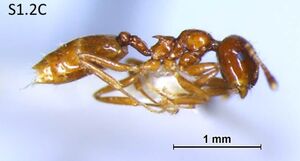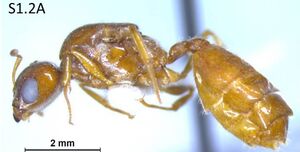Crematogaster linsenmairi
| Crematogaster linsenmairi | |
|---|---|

| |
| Scientific classification | |
| Kingdom: | Animalia |
| Phylum: | Arthropoda |
| Class: | Insecta |
| Order: | Hymenoptera |
| Family: | Formicidae |
| Subfamily: | Myrmicinae |
| Tribe: | Crematogastrini |
| Genus: | Crematogaster |
| Species group: | decamera |
| Species subgroup: | captiosa |
| Species: | C. linsenmairi |
| Binomial name | |
| Crematogaster linsenmairi Feldhaar, Maschwitz & Fiala, 2016 | |
A widespread member of a group of Crematogaster species associated with Macaranga plants in Sumatra, Borneo, and Peninsula Malaysia.
Identification
Feldhaar et al. (2016) - A member of the Crematogaster captiosa subgroup within the Crematogaster borneensis group. Worker: Propodeal spines present, scape index (SI)> 0.65, RLEG > 0.7, rarely below. Queen: EL rarely < 0.65mm, REL 0.39 - 0.48, OD1 < OW, scape length >0.75 mm.
Keys including this Species
Distribution
Known from Sumatra, Borneo, and Peninsula Malaysia.
Latitudinal Distribution Pattern
Latitudinal Range: 4.23807° to 4.2022°.
| North Temperate |
North Subtropical |
Tropical | South Subtropical |
South Temperate |
- Source: AntMaps
Distribution based on Regional Taxon Lists
Indo-Australian Region: Singapore (type locality).
Distribution based on AntMaps
Distribution based on AntWeb specimens
Check data from AntWeb
Countries Occupied
| Number of countries occupied by this species based on AntWiki Regional Taxon Lists. In general, fewer countries occupied indicates a narrower range, while more countries indicates a more widespread species. |

|
Estimated Abundance
| Relative abundance based on number of AntMaps records per species (this species within the purple bar). Fewer records (to the left) indicates a less abundant/encountered species while more records (to the right) indicates more abundant/encountered species. |

|
Biology
Feldhaar et al. (2016) - Crematogaster linsenmairi is the largest species of the Macaranga-associated Crematogaster captiosa-subgroup. This species is found over the whole distributional range of the association. It colonizes mainly hosts of the section Pruinosae whose stems need to be actively excavated and have a waxy cover (Macaranga hosei, Macaranga pearsonii, Macaranga pruinosa but also on non-waxy Macaranga puberula). It is also found very rarely on hosts of the section Pachystemon (e.g., Macaranga aetheadenia, Macaranga kingii, Macaranga lamellata, and Macaranga motleyana) in areas where the usual host species are absent (Fiala et al., 1999).
In parts of Borneo (Sabah) foundress association of unrelated individuals of this species have been found in areas with strong nest site limitation. These colonies stay polygynous even after emergence of workers and several queens may produce offspring (Feldhaar et al., 2005). Virgin alate queens have been found to be parasitized by the phorid fly Trucidophora feldhaarae while still inside the nest within the hollow stem of their host plant on Peninsula Malaysia (Maschwitz et al., 2006).
Castes
Worker
         
| |
| . | |
Queen
 
| |
| . | |
Nomenclature
The following information is derived from Barry Bolton's Online Catalogue of the Ants of the World.
- linsenmairi. Crematogaster linsenmairi Feldhaar, et al. 2016: 667, fig. S1.2A-D (w.q.) SINGAPORE.
- Type-material: 2 syntype workers.
- Type-locality: Singapore: 14:108 (H. Overbeck).
- Type-depository: MNHU.
- Material of the unavailable name tubuli referred here by Feldhaar, et al. 2016: 667.
- Status as species: Wang, W.Y., Soh, et al. 2022: 76.
- Distribution: Malaysia (Peninsula, Sabah, Sarawak), Singapore.
Unless otherwise noted the text for the remainder of this section is reported from the publication that includes the original description.
Description
Worker
Syntype. (n=2) CI 0.94-0.97, DPPW 0.19, DPW 0.2-0.21, EL 0.15, HL 0.69-0.72, HW 0.68, SL 0.49, MTW – (not fully visible), LHT 0.53-0.76, SI 0.71, LPS 0.13, PI 1.05-1.08, REL 0.2- 0.21, RLEG 0.71, (TL 2.8) WL 0.82-0.83.
(n=13) CI 0.94-1.02, DPPW 0.16-0.24, DPW 0.17-0.25, EL 0.13-0.17, HL 0.66-0.86, HW 0.63-0.86, LHT 0.53-0.76, LPS ,0.81-1.181, MTW 0.38-0.53, PI 0.93-1.08, REL 0.17-0.21, RLEG 0.68-0.79, SI 0.68-0.76, SL 0.47-0.59, (TL 2.7-3.8), WL 0.82-1.07
Workers brown in colour (large workers) with head and gaster a slightly darker shade than the alitrunk. Workers monomorphic in size. Total body length of workers 2.7 to 3.8 mm. Head and gaster shiny with smooth surface, alitrunk slightly less shiny and faintly shagreened. All body parts bear appressed pubescent hairs. Long flexuous setae present on head gaster and abdomen: on head especially in frons, on gaster more on the posterior margins of tergites and sternites. Only few setae on alitrunk and one pair each on petiole and postpetiole.
Head subquadratic but slightly elongated, usually being longer than wide (mean CI: 0.97) and only slightly convex on sides. Anterior clypeal margin slightly convex and with a row of long erect setae projecting anteriorly. Occipital margin slightly concavely rounded, occipital lobes rounded. Mandibles relatively short and with four denticles, capable of closing tightly against the clypeus. Denticles increasing continuously in size from most proximate to most distal denticle. Surface of mandibles smooth, covered with short pubescent hairs.
Antennae are relatively long in comparison to head width (SI 0.68-0.76; mean 0.72) and covered in short pubescent hair. Terminal three funicular segments form a club, sometimes only the terminal two segments.
Compound eyes elliptically shaped and not protruding over margin of head in full-face view. Pronotum and mesonotum form a convex dome in profile, sometimes slightly flattened dorsally. Anterodorsal surface of pronotum sloping downwards slightly steeper than or as steep as posterodorsal surface of mesonotum. The metanotal groove is slightly notched and clearly developed, whereas the promesonotal suture is visible but not prominent.
Propodeal spines in lateral view strong and acute. Tip of the spines always protruding over posterior margin of the propodeal spiracle and are diverging very slightly. Dorsal face of the propodeum confluent with the horizontal spines or spines bent slightly upwards. Slope of the posterior face of the propodeum similar to posterior slope of mesonotum.
In dorsal view petiole approximately as wide as postpetiole (PI: 0.96-1.08). Node of petiole in dorsal view longer than wide and considerably rounded, dorsal surface flat. In profile the anterior face of the petiolar node shorter than the posterior so that the dorsal surface slopes downwards anteriorly. Dorsal surface of the postpetiolar node in profile rounded. Subpetiolar process usually absent.
Queen
CI 0.93-1.04, DPPW 0.48-0.62, DPW 0.46-059, EL 0.58- 0.71, HL 1.34-1.61, HW 1.30-1.62, LHT 1.06-1.37, MTW 1.13- 1.34, OD1 0.11-0.2, OD2 0.02-0.08, OW 0.16-0.21, PI 0.89-1.04, REL 0.39-0.48, RLEG 0.42-0.49, ROD 0.07-0.14, ROD2 0.018- 0.057, SI 0.54-0.61, SL 0.74-0.88, (TL 6.8-9.3), WL 2.45-2.9
Queens are the largest of all Macaranga-associated Crematogaster borneensis-group; with total body length ranging from approximately 6.8 to 9.3 mm and uniformly medium brown in colour. Surface of head and gaster smooth and shiny, alitrunk is slightly less shiny and faintly shagreened. All body parts bear appressed pubescent hairs. Long flexuous setae present on head gaster and abdomen: on head especially in frons, on gaster more on the posterior margins of tergites and sternites. A row of long erect setae pointing anterior are present on the clypeus. Mandibles relatively short, capable of closing tightly against the clypeus.
Head subquadratic, being usually approximately as wide as long (CI: 0.93-1.04; mean 0.99). Sides of the head only very slightly convex, occipital margin of the head slightly concave. Occipital lobes rounded. Anterior clypeal margin slightly convex. Terminal 3 segments of funiculus continuously increasing in size forming an indistinct antennal club. Antennal scrobes strongly developed, with an acute and marked dorsal margin; the frontal carinae short.
Compound eyes large (rarely below 0.6 mm) and span more than one third of HL. Compound eyes oval-shaped from lateral view and convex from dorsal view with margins of compound eyes protruding distinctly over margin of head. Maximum width of head including compound eyes between 8 to 16% wider than HW. Ocelli relatively large in diameter. Diameter of median ocellus larger than distance between the lateral ocelli.
Mesoscutum convexly rounded anterodorsally. Mesoscutellum nearly in horizontal plane in lateral view. Propodeum flattened dorsally and then drops off at an angle of approximately 45° posterior of the propodeal spiracle. Mesoscutum long, stretching out over approximately half of the alitrunk in lateral view. In dorsal view, the posterior margin of the propodeum forms a straight line and the mesonotum is broadly triangular. Propodeum not armed with spines.
Node of petiole in dorsal view roughly rectangular, anterior side broader than posterior one. Petiolar node round in shape in dorsal view and often, but not always not as wide as postpetiolar node. In lateral view the petiole anterodorsally flattened and sloping downwards and slightly longer than the postpetiole. Postpetiole trapezoid-shaped in dorsal view and broader anterior than posterior. Petiole and postpetiole do not have distinct nodes.
Type Material
Crematogaster borneensis subsp. hosei var. tubuli (Viehmeyer, 1916), Syntypes, 2 workers, Singapore (Overbeck) (Berlin Museum für Naturkunde der Humboldt-Universität) [unavailable name].
Determination Clarifications
In former publications by our group this species has been referred to as Crematogaster msp. 2 (Fiala et al., 1999; Feldhaar et al., 2003a; Feldhaar et al., 2005; Feldhaar et al., 2010).
References
- Feldhaar, H., Maschwitz, U., Fiala, B. 2016. Taxonomic revision of the obligate plant-ants of the genus Crematogaster Lund (Hymenoptera: Formicidae: Myrmicinae), associated with Macaranga Thouars (Euphorbiaceae) on Borneo and the Malay Peninsula. Sociobiology. 63: 651-681.
- Wang, W.Y., Soh, E.J.Y., Yong, G.W.J., Wong, M.K.L., Benoit Guénard, Economo, E.P., Yamane, S. 2022. Remarkable diversity in a little red dot: a comprehensive checklist of known ant species in Singapore (Hymenoptera: Formicidae) with notes on ecology and taxonomy. Asian Myrmecology 15: e015006 (doi:10.20362/am.015006).
References based on Global Ant Biodiversity Informatics
- Feldhaar H., U. Maschwitz, and B. Fiala. 2016. Taxonomic revisions of the obligate plant-ants of the genus Crematogaster Lund (Hymenoptera: Formicidae: Myrmicinae), associated with Macaranga Thouars (Euphorbiaceae) on Borneo and the Malay Peninsula. Sociobiology 63(1): 651-681.

